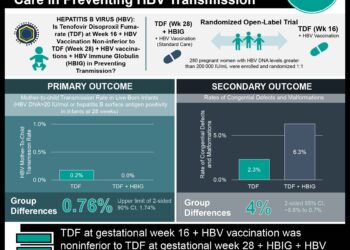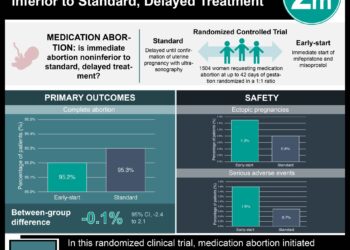Wellness Check: Addictions
2 Minute Medicine is pleased to announce that we are launching Wellness Check, a new series dedicated to exploring new research evidence focused on wellness. Each week, we will report on articles examining different aspects of wellness, including (but not limited to) nutrition, sleep, reproductive health, substance use and mental health. This week, we explore the latest evidence-based updates in addictions.
Prenatal medication for opioid use disorder helps discharge infants back to mothers
1. In this study, medication prescribed for opioid use disorder amongst pregnant women often allowed newborn infants to be discharged to their parents, rather than relatives or foster care.
2. However, more than half of eligible women in this study did not receive medication for opioid use disorder.
Evidence Rating Level: 3 (Average)
Opioid use during pregnancy has increased steadily since the 2000s in the United States and remains a serious issue with no clear answer. Opioid use during pregnancy can lead to several adverse events including maternal adverse events as well as neonatal opioid withdrawal syndrome (NOWS). Medication for opioid use disorder (MOUD) is the standard treatment for opioid use disorder, includes medications such as methadone and buprenorphine. The purpose of this study was to identify maternal and neonatal factors associated with use of MOUD and determine the impact of receipt of MOUD on discharge to parents for infants born with NOWS.
This study used data from 3 Alaska, United States hospitals: Alaska Native Medical Center, Yukon Kuskokwim Delta Regional Hospital, and Fairbanks Memorial Hospital from July 2016-December 2019. From this dataset, only infants born with NOWS as defined by the Finnegan Neonatal Abstinence Scoring System were included (n=193). Infants were excluded if they were <36 weeks gestation or had any major birth defects. MOUD, whether the infant was discharged home to parents, maternal and perinatal care characteristics were recorded.
The results demonstrated that receiving MOUD during pregnancy increased the odds of an infant with NOWS being discharged home to parents by 4 times, indicating that MOUD during pregnancy may help keep families together. However, more than half of the mothers did not receive MOUD in this study, indicating need for greater access. However, this study was limited, as its relatively small sample size, and selective inclusion of clinics in Alaska. Despite these limitations, the results suggest that MOUD during pregnancy may help keep families together during discharge planning.
Telemedicine bridge clinics may be helpful for opioid use disorder treatment
1. In this study, telemedicine bridge clinics had high show rate and allowed patients to fill prescriptions for opioid use disorder.
2. There was no significant difference in patients who were evaluated with audio-only versus audiovisual techniques.
Evidence Rating Level: 2 (Good)
Opioid use has increased steadily since the 2000s and remains a serious epidemic. Furthermore, due to the COVID-19 pandemic, the number of overdose deaths were exacerbated. Treatment of opioid use disorder (OUD) includes medications such as opioid agonist medications, but there are many barriers for patients seeking care. The purpose of this study was to determine whether a telemedicine bridge clinic could help facilitate engagement for those with OUD.
This study examined the UPMC Medical Toxicology Telemedicine Bridge Clinic (Pennsylvania, United States) between April 27, 2020 – July 31, 2021. Only patients who agreed to be part of the bridge clinic were included. Patients were evaluated with either audio-only or audiovisual methods. Electronic health records were used to obtain medical record numbers, gender, and other demographic information. Results of the study were primarily descriptive in nature to see if such a clinic could serve as a model for other telemedicine bridge clinics.
In this study, 208 patient visits were scheduled, with 200 being evaluated by physicians. The results show that 77% of the Bridge Clinic patients filled 2 or more buprenorphine prescriptions after their initial visit, indicating high engagement. Most of the patients (62%) had insurance through Medicaid, though 19% were uninsured. Outcomes were similar between those who used phone-only versus audiovisual visits. However, this study was limited due to lack of long-term follow up and the use of a single clinic, limiting generalizability. Despite these limitations, the results suggest that telemedicine bridge clinics may be useful long-term for patients suffering from OUD.
Spectrophotometric assays for methadone may be effective for diversion control
1. Methadone is a regulated medication that is effective in treating opioid use disorder; however, diversion of take-home methadone can occur and is difficult to detect.
2. One method of detection may be to utilize a handheld spectrophotometric assay to detect doses of methadone that may have been altered by the patient.
Evidence Rating Level: 2 (Good)
Opioid use disorder is a condition which may be treated with a variety of medications, including methadone. However, there is a risk of diversion, defined as patients selling or giving away their methadone to others. Methadone has a narrow margin of safety and the potential for dangerous results such as overdose on diverted methadone exists. The purpose of this study was to determine whether a low-cost ultraviolet (UV) light spectrometer could be used to determine if methadone doses were altered at home, which could potentially detect instances of diversion.
This study used methadone liquid concentrate obtained by several suppliers, with the largest being Roxane Laboratories (Columbus, Ohio, United States), with the study being conducted in South Burlington, Vermont, United States. 10 methadone doses were prepared as controls to determine confidence intervals. These doses were compared to 104 random bottles obtained over a 10 month period, followed by an additional 103 bottles with concern for diversion from 27 patients collected over an additional 14 month period. UV-visible spectrophotometry was then performed on these samples, and methadone concentrations were recorded.
The results demonstrated that spectrophotometry may be a viable method to determine whether diversion had occurred. Out of the bottles with concern for diversion, 15 had <25% and 8 had <75% of the expected concentration. However, this study did note limitations of the spectrophotometry assay, such as the expense of the instrumentation, and the requirement for clinical staff to become acquainted with performing the intrinsic steps necessary for operation of the instrumentation. Despite these limitations, this pilot study suggests that spectrophotometry may be an easy, low-cost way of determining some instances of methadone diversion.
Image: PD
©2022 2 Minute Medicine, Inc. All rights reserved. No works may be reproduced without expressed written consent from 2 Minute Medicine, Inc. Inquire about licensing here. No article should be construed as medical advice and is not intended as such by the authors or by 2 Minute Medicine, Inc.







